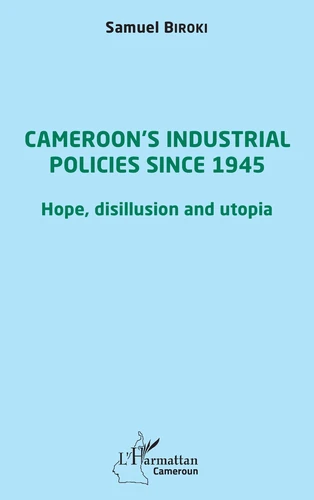Cameroon's industrial policies since 1945. Hope, disillusion and utopia
Par :Formats :
- Paiement en ligne :
- Livraison à domicile ou en point Mondial Relay indisponible
- Retrait Click and Collect en magasin gratuit
- Réservation en ligne avec paiement en magasin :
- Indisponible pour réserver et payer en magasin
- Nombre de pages216
- PrésentationBroché
- FormatGrand Format
- Poids0.274 kg
- Dimensions13,5 cm × 21,5 cm × 1,2 cm
- ISBN978-2-343-23812-8
- EAN9782343238128
- Date de parution09/12/2021
- ÉditeurL'Harmattan
Résumé
Obviously, the year 1945 can be recognised in this work as the beginning of the industrial adventure of Cameroon. Thus, the period of this essay can be structured into three cycles : 1945 to 1985, during which the economic potential of the country flourished to reach the heights of Africa's industrialised nations. This hope faded between 1986 and 2009 due to a poor industrial governance ; and since 2010, the announced Emergence perspective has been receding due to economic under-performance.
It should be noted that the economic crisis which started from 1986/1987 revealed the fragility of the productive system due to the impacts still lurking around, in spite of generic measures administered by the Bretton Woods organisations to strengthen all the distressed economies in Africa. Upon reflection, Cameroon's industrial policy is not yet formally theorized. Rather, it is conceived within Industrialisation Master Plans and instrumentalised by an authoritarian bureaucracy steering a dual economy through industrial projects distributed in the agricultural and mining sectors.
The development plans, which some analysts praise, have demonstrated their relative effectiveness. This book allows for a balanced evaluation of the levers of industrial competitiveness and anticipates the economic emergence of Cameroon, which is conditioned by the combination of institutional, corporate, social and territorial intelligence.
It should be noted that the economic crisis which started from 1986/1987 revealed the fragility of the productive system due to the impacts still lurking around, in spite of generic measures administered by the Bretton Woods organisations to strengthen all the distressed economies in Africa. Upon reflection, Cameroon's industrial policy is not yet formally theorized. Rather, it is conceived within Industrialisation Master Plans and instrumentalised by an authoritarian bureaucracy steering a dual economy through industrial projects distributed in the agricultural and mining sectors.
The development plans, which some analysts praise, have demonstrated their relative effectiveness. This book allows for a balanced evaluation of the levers of industrial competitiveness and anticipates the economic emergence of Cameroon, which is conditioned by the combination of institutional, corporate, social and territorial intelligence.
Obviously, the year 1945 can be recognised in this work as the beginning of the industrial adventure of Cameroon. Thus, the period of this essay can be structured into three cycles : 1945 to 1985, during which the economic potential of the country flourished to reach the heights of Africa's industrialised nations. This hope faded between 1986 and 2009 due to a poor industrial governance ; and since 2010, the announced Emergence perspective has been receding due to economic under-performance.
It should be noted that the economic crisis which started from 1986/1987 revealed the fragility of the productive system due to the impacts still lurking around, in spite of generic measures administered by the Bretton Woods organisations to strengthen all the distressed economies in Africa. Upon reflection, Cameroon's industrial policy is not yet formally theorized. Rather, it is conceived within Industrialisation Master Plans and instrumentalised by an authoritarian bureaucracy steering a dual economy through industrial projects distributed in the agricultural and mining sectors.
The development plans, which some analysts praise, have demonstrated their relative effectiveness. This book allows for a balanced evaluation of the levers of industrial competitiveness and anticipates the economic emergence of Cameroon, which is conditioned by the combination of institutional, corporate, social and territorial intelligence.
It should be noted that the economic crisis which started from 1986/1987 revealed the fragility of the productive system due to the impacts still lurking around, in spite of generic measures administered by the Bretton Woods organisations to strengthen all the distressed economies in Africa. Upon reflection, Cameroon's industrial policy is not yet formally theorized. Rather, it is conceived within Industrialisation Master Plans and instrumentalised by an authoritarian bureaucracy steering a dual economy through industrial projects distributed in the agricultural and mining sectors.
The development plans, which some analysts praise, have demonstrated their relative effectiveness. This book allows for a balanced evaluation of the levers of industrial competitiveness and anticipates the economic emergence of Cameroon, which is conditioned by the combination of institutional, corporate, social and territorial intelligence.







